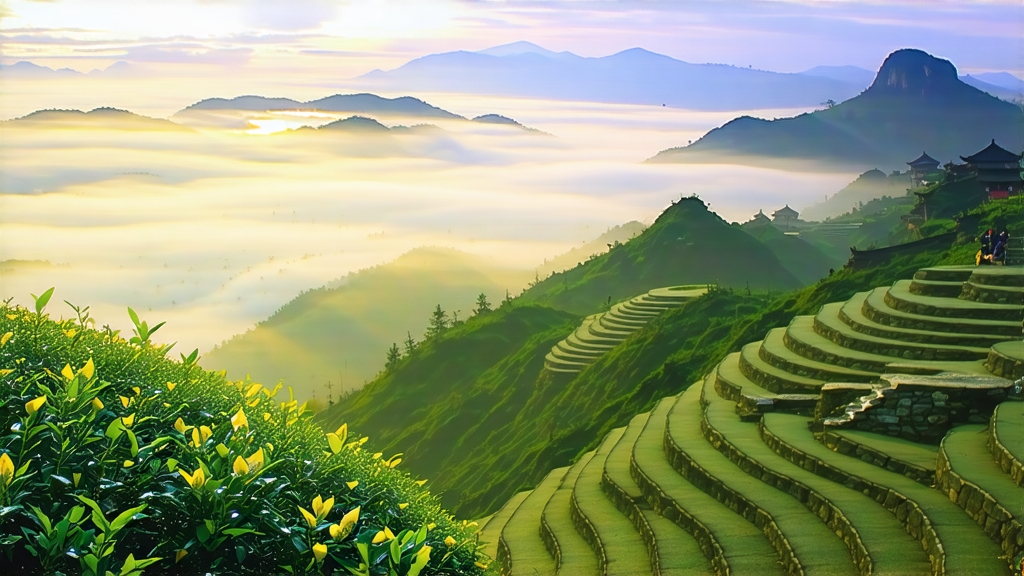
Tucked away in the cloud-veiled peaks of Sichuan’s Meng Ding mountain, Meng Ding Huang Ya—literally “Meng Ding Yellow Bud”—has been whispering its mellow secrets for more than twelve centuries. Foreign tea lovers often greet yellow tea with blank stares; even inside China it is the rarest of the six major tea families. Yet this particular yellow bud once rode the postal roads of the Tang dynasty as tribute to the emperor, packed in silk and escorted by mounted guards. Today only a few hundred kilos leave the mountain each spring, most destined for private collectors or state banquets. To hold a cup of Meng Ding Huang Ya is to taste a vanished court etiquette, a slow oxidation art that almost disappeared during the turmoil of the twentieth century, and a landscape where monks once measured rainfall by the sound of tea leaves unfurling.
Historical whispers
The first written record appears in 808 CE, when the monk Gan Lu (“Sweet Dew”) presented a “yellow sprout” from Meng Ding to the Tang court. Song dynasty gazetteers list it among the “Eight Imperial Tributes of Sichuan,” and the Ming emperor Wan Li (r. 1572–1620) decreed that every picked bud must pass through a single official gate, an early form of origin control. When the Qing turned to darker puer and fragrant oolong, Meng Ding Huang Ya retreated into monastery gardens, surviving because Buddhist abbots valued its gentle qi and low caffeine for night-long meditation. Republican-era warlords chopped many bushes for firewood; the 1950s restoration team could find only 38 mother plants. From those survivors clonal gardens were established at 800–1 400 m, preserving the original Xiaoye (small-leaf) landrace that gives the tea its signature orchid-chestnut aroma.
Micro-terroir in the sky
Meng Ding sits on the western edge of the Sichuan basin, catching both monsoon moisture and Tibetan plateau chill. Morning clouds act like a silk curtain, filtering UV and forcing the plant to manufacture more theanine. The soil is a crumbly purple sandstone rich in selenium and zinc; locals joke that the mountain “sweats mineral water.” Temperature swings of 15 °C between day and night slow growth so drastically that the spring picking window lasts barely ten days, usually 20–30 March. A single mu (1⁄15 hectare) yields just 3 kg of finished buds, making every leaf a condensed capsule of altitude, stone and mist.
The yellowing miracle
Western texts often mistranslate huang cha as “fermented,” yet the defining step is a non-enzymatic yellowing unique to this family. After kill-green at 160 °C on a cast-iron wok, the buds are wrapped still hot in thick parchment paper and left to suffocate for 70–90 minutes. During this micro-sauna chlorophyll degrades into pheophytin, polyphenols oxidise just 5–8 %, and a veil of amino acids condenses on the leaf surface. The process is repeated three times with progressively longer wraps, each cycle followed by low-temperature baking over charcoal embers. The result is a colour that hovers between matte gold and tender bamboo—never the grassy green of early spring, never the copper of black tea. Masters judge readiness by rubbing a bud between the palms: it should squeak like fine suede and release a scent of warm pumpkin and lilies.
Grades and garden styles
Ming Qian Single Bud (before Qingming festival) is the pinnacle: 100 % unopened tips, 8 000 buds per 100 g, needle-straight with a downy silver reverse. Gu Yu One Leaf and a Bud (picked around Grain Rain) offers a slightly bolder liquor and is preferred by Sichuan chefs for pairing with twice-cooked pork. A third grade, Que She (“Sparrow Tongue”), includes two tiny leaves and is flash-roasted in bamboo tubes for a smoky note once loved by caravan traders. Purists insist that true Meng Ding Huang Ya can come only from the original 1.2 km² core zone around the Gan Lu Temple; everything else is labelled “Meng Ding-type” and sells for a third of the price.
Crafting in the monk’s kitchen
I spent last spring with master Liang Guoqing, a 68-year-old whose family has fired the temple kilns since 1857. At 3 a.m. he